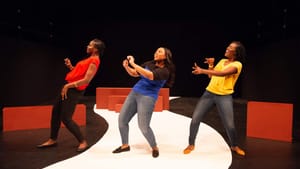Stay in the Loop
BSR publishes on a weekly schedule, with an email newsletter every Wednesday and Thursday morning. There’s no paywall, and subscribing is always free.
Over the rainbow
The Wilma Theater presents ‘Renaissance in the Belly of a Killer Whale’

A century after the Harlem Renaissance, Jaylene Clark Owens’s Renaissance in the Belly of a Killer Whale, now onstage at the Wilma, reflects on what beloved Harlem once was and has now become.
The title is a mouthful and the play is an earful. With a three-person cast, nonstop dialogue, no intermission or acts, and a minimalist set (sparse black-and-white backdrop alluding to a killer whale’s belly and red blocks representing a brownstone’s front stoop), Renaissance provides little for the visual imagination. Instead, it forces you to listen, and to whom you are listening matters because it is not often that three Black women command and are given the uninterrupted and uncontested space, time, and attention of an entire audience. That in itself is a triumph.
Signs of change
Renaissance tells the tale of three friends who grew up together in Harlem and have reunited to lament how gentrification has made their neighborhood unrecognizable. While the play is specific to Harlem, it could take place in any major city that is undergoing similar redevelopment and demographic shifts, including Philadelphia.
Some signs of change are universal and indisputable: a new coffee shop or Trader Joe’s pops up; the dogs per capita rise faster than your pay; and your neighborhood is suddenly rebranded as something like “SoHa” or “NoLibs” or “University City.” These forces cause neighborhoods and cities to start to resemble the belly of a killer whale, with whiteness expanding and concentrating at the center and blackness being pushed further towards the margins. While not the most subtle analogy, it is effective in making clear the perspectives of the protagonists.
Echoes of Shange
Owens, Janelle Heatley, and Hollis Heath star in the show and share co-writer credit with Chyann Sapp (the show’s concept grew out of a 2011 Facebook post about gentrification by Owens). As an ensemble, their camaraderie and connection are clear. The best parts of the show are when their voices harmonize, their dance moves synchronize, or when their hands clap in unison to symbolize either a flashback or scene change. A 2019 Barrymore Award-winner and Wilma Hothouse resident, Owens anchors the cast while also serving as director. Heatley is a solid supporting actor, at one point becoming the literal drumline and percussion section of a song. Heath’s performance stands out as the most versatile and effortless of the three.
Throughout the show, I noticed glimmers of Ntozake Shange’s classic for colored girls who have considered suicide/when the rainbow is enuf. Both star an all-Black female cast dressed in different primary colors; both feature song, dance, and spoken word woven throughout their narratives; and both are set in Harlem.
Deeper perspectives needed
But among all that color, I was missing more shades of gray—the messiness, the nuance, the ambiguity of growth and change. Renaissance fails to go beyond a basic understanding of gentrification and misses a major opportunity to add a fresh perspective or deeper analysis to the existing discourse.
There were two especially interesting points that were briefly discussed and could’ve made a bigger impact, given more time for unpacking: the complicity of Black gentrifiers, and the differences between positive revitalization and reinvestment in current communities versus exploitative redevelopment and erasure. Despite acknowledging these, the play still spends a significant amount of time centering whiteness, either in mocking and imitating white people, or appealing to them to acknowledge Black achievements and contributions.
What we could demand
What we now call the Harlem Renaissance was referred to as “The New Negro Movement” by the artists and musicians synonymous with that era, like Zora Neale Hurston, Duke Ellington, or Langston Hughes. Periods are only named a “renaissance” in retrospect because we view the past with rose-tinted glasses. It is easier to reflect fondly on some mythical and idealistic yesteryear than to grapple with what is right in front of you. But in the current climate, where nostalgia and historical recollection are highly politicized, some of the most important work we can do is reimagine what is possible in the present and future. Instead of a renaissance, why don’t we demand a revolution?
What, When, Where
Renaissance in the Belly of a Killer Whale. By Jaylene Clark Owens, Hollis Heath, Janelle Heatley, and Chyann Sapp. Directed by Jaylene Clark Owens. Through March 7, 2020 at the Wilma Theater, 265 S. Broad St. (215) 546-7824 or wilmatheater.org.
The Wilma Theater is an ADA-compliant venue, but its narrow lobby makes it difficult to navigate in a crowd. Limited wheelchair seating can be reserved in advance.
Sign up for our newsletter
All of the week's new articles, all in one place. Sign up for the free weekly BSR newsletters, and don't miss a conversation.

 Hanae Mason
Hanae Mason